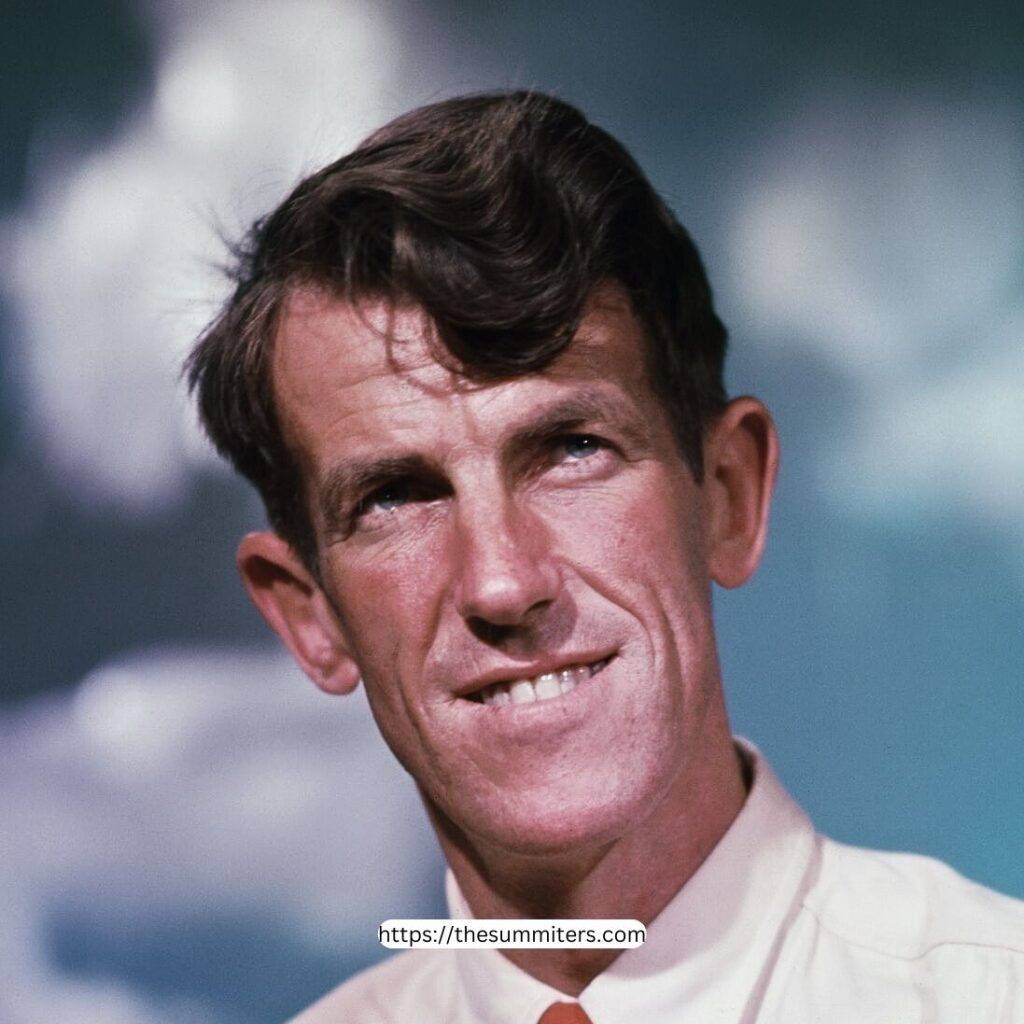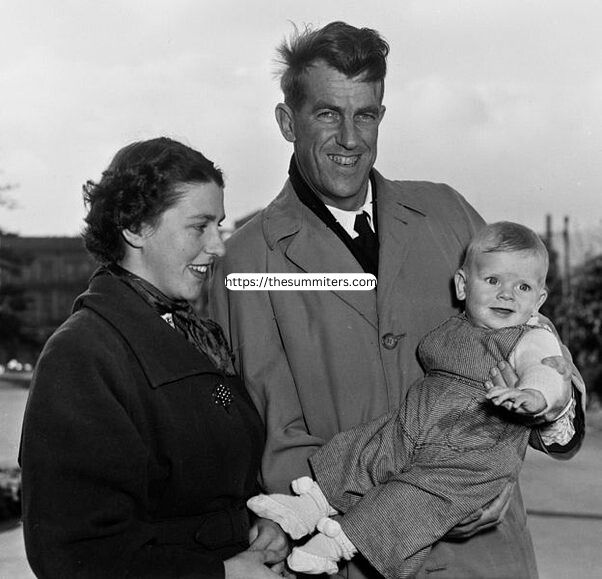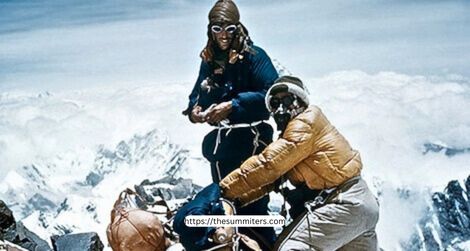
Sir Edmund Hillary (1919-2008) is broadly known as one of the most iconic figure in the history of exploration particularly celebrated for his remarkable journey to the top of Mount Everest in 1953. Born in Auckland New Zealand. Hillary’s passion for the great outdoors and mountains glowed from a young age. He edged his mountaineering skills in the Southern Alps of New Zealand which ultimately make his way to conquering the Earth’s highest peak.
The highlight of Hillary’s legacy happened on May 29 1953, when alongside his Sherpa guide Tenzing Norgay he achieved the extraordinary feat of becoming the first human to reach the summit of Mount Everest which stands at a breathtaking 29029 feet (8,848 meters) above sea level. This historic achievement was a groundbreaking moment in the realm of exploration and mountain climbing, captivating the imagination of people worldwide and inspiring countless adventurers.
But Sir Edmund Hillary’s impact extended far beyond his Everest triumph. He dedicated his life to exploration, humanitarian efforts, and environmental conservation. He participated in numerous Himalayan expeditions, conquering other formidable peaks. Yet, it was his commitment to improving the lives of the Sherpa people in Nepal that truly showcased his humanitarian spirit. He played a vital role in constructing schools, hospitals, and infrastructure to uplift Sherpa communities and enhance their quality of life, earning enduring gratitude and respect from those he served.
Recognition of Hillary’s achievements went beyond the mountaineering community. In 1953 he was ennobled by Queen Elizabeth II becoming “Sir Edmund Hillary.” Additionally he received various humanitarian and environmental awards for his contributions to the welfare of the Nepalese people and his efforts to preserve the environment in the Antarctic.
In addition to his adventurous exploits, Hillary was a skilled author. His books, such as “High Adventure” and “No Latitude for Error,” offered readers a vivid window into the world of exploration, mountaineering, and the challenges faced during these epic journeys. He was also a sought-after public speaker, sharing his tales and wisdom with audiences worldwide.
Sir Edmund Hillary’s legacy encircles not only his unparalleled achievements in exploration but also his steady commitment to humanitarian work and environmental preservation. He remains an enduring symbol of adventure, resilience, and service to humanity, serving as an inspiration to generations of adventurers, conservationists, and philanthropists, with his name firmly engraved in the pages of history.
Sir Edmund Hillary’s Early Life
Sir Edmund Hillary’s constructive years were formed by a series of significant experiences that put the foundation for his exceptional career in mountaineering exploration and humanitarian endeavors.
Born on July 20, 1919 in Auckland New Zealand, Edmund Hillary was the second of three siblings. His family though not well off embedded in him a profound appreciation for the natural world and outdoor pursuits. Growing up in the rural outskirts of Auckland, young Hillary had easy access to the wilderness, fostering a deep-seated love for the outdoors from an early age.
Hillary’s initial encounter with mountains took place during a school excursion to Mount Ruapehu, an active volcano on New Zealand’s North Island. This adventure sparked his passion for mountaineering, setting him on the path to exploring the country’s local peaks and refining his hiking and climbing skills. His affection for the mountains was further nurtured when he joined the Auckland Tramping Club, where he acquired crucial mountaineering techniques and gained valuable hands-on experience.
World War II briefly interrupted Hillary’s pursuits, as he served as a navigator in the Royal New Zealand Air Force. While the war itself was a demanding and often perilous experience, it equipped him with a solid grounding in navigation, survival skills, and leadership abilities, all of which would prove invaluable in his future endeavors.
Following the war, Hillary returned to his beloved mountains, continuing to enhance his mountaineering expertise. He gained a reputation as a proficient and determined climber within New Zealand’s mountaineering community. His unwavering resolve and outdoor proficiency earned him an invitation to join the 1951 British reconnaissance expedition to Mount Everest, led by Eric Shipton. Though this particular expedition didn’t reach the summit, it was a pivotal experience that provided Hillary with invaluable insights into high-altitude mountaineering and set him on a trajectory toward even greater accomplishments.
Throughout his formative years Hillary also recognized the importance of education. He attended the esteemed Auckland Grammar School and later pursued studies in mathematics and science at the University of Auckland. Nevertheless, his passion for the mountains and exploration eventually took precedence over formal academic pursuits.
In brief, Sir Edmund Hillary’s early life was characterized by a childhood deeply intertwined with nature, an introduction to mountains at a tender age, and the cultivation of indispensable skills during World War II. His involvement with the Auckland Tramping Club, his participation in the 1951 Everest expedition, and his commitment to perfecting his mountaineering abilities all played pivotal roles in molding his extraordinary journey as one of the world’s most celebrated and accomplished explorers and mountaineers.
Personal Life
Beyond his legendary adventures Sir Edmund Hillary’s personal life was just as charismatic. Born as the second of three siblings to Percival and Gertrude Hillary in New Zealand, his upbringing instilled a profound love for the great outdoors and the spirit of adventure. This childhood connection to nature would go on to shape his later life as an explorer.
Remarkably despite his extraordinary achievements Hillary was known for his humility and down to earth nature. He carried himself with a sense of humility and was often reluctant to relax in the spotlight a quality that endeared him to people from all walks of life.

In 1953, the same year he conquered the summit of Mount Everest, Hillary tied the knot with Louise Mary Rose, affectionately known as “Lou.” The couple raised three children together: Peter, Sarah, and Belinda. His family life provided a sense of equilibrium and steadiness amidst his thrilling adventures.
Beyond his pursuits in mountaineering and exploration, Hillary had a wide range of interests. He was an enthusiastic beekeeper, a passion he inherited from his father. His love for beekeeping remained a constant throughout his life, and he even introduced a unique strain of honeybee to the Everest region, benefitting the Sherpa community.
One other noteworthy aspect of Hillary’s personal life was his profound commitment to humanitarian causes. His experiences during the Everest expedition served as a incentive for dedicating a significant portion of his life to improving the living conditions education and healthcare of the Sherpa people.
Sir Edmund Hillary peacefully passed away in Auckland New Zealand, on January 11, 2008 at the age of 88. His legacy continues to serve as a source of inspiration for people all over the world exemplifying the impact one person can have through unwavering dedication and a humble spirit, both in the scope of adventure and in service to others.
Sir Edmund Hillary’s 1st Attempt to Everest
The 1953 Everest expedition arranged by Colonel John Hunt and finishing in Sir Edmund Hillary and Tenzing Norgay’s historic journey to the summit of Mount Everest is a engaging story of diligent planning steady determination and the success of the human spirit. This ground breaking expedition marked a pivotal moment in the history of mountain climbing and exploration.
Colonel John Hunt assembled a diverse and international team of climbers, including members from various Commonwealth nations. Notably, Sir Edmund Hillary represented New Zealand, and Tenzing Norgay, an accomplished Sherpa mountaineer from Nepal, was among them. The team brought together a wealth of experience and skills, all sharing a common mission to conquer the world’s highest peak.
The arduous journey to Everest presented numerous challenges. The climbers had to navigate treacherous terrain extreme altitudes unpredictable weather and a lack of the modern climbing gear we take for granted today. As they advanced toward the summit they encountered numerous barriers and tragedies that strictly tested their physical and mental strength.
The final push to the summit of Mount Everest was arguably the most perilous part of the expedition. After establishing a series of high-altitude camps, Hillary and Tenzing embarked on their ascent. The last leg of their journey was fraught with danger, including the precarious South Col and the formidable Hillary Step. Nevertheless their persistent decision and perfect teamwork ultimately carried them to the pinnacle of the world.
Sir Edmund Hillary & Tenzing Norgay The 1st Humans who Summited Everest

On 29 May 1953 Sir Edmund Hillary and Tenzing Norgay achieved the unusual stunt of becoming the first human to stand on top of the Mount Everest. Their remarkable achievement captured the world’s imagination and remarkable the beginning of a new age in high altitude mountaineering. News of their success spread quickly and they received worldwide glory for their wise achievement.
This historic ascent not only stiffened Hillary’s status as a legendary figure in the world of exploration but also counterfeit a esoteric and enduring bond between the people of New Zealand and Nepal. Hillary and Norgay’s triumph served as a symbol of what could be achieved through persistence, cooperation, and an unwavering spirit in the face of seemingly insurmountable challenges. The 1953 Everest expedition remains an iconic and inspiring moment in the history of human exploration.
Read More: Mount Everest Helicopter Crash – 2023
After Everest
Following his historic conquest of Mount Everest in 1953, Sir Edmund Hillary’s life unfolded as a series of remarkable achievements, highlighting not only his exceptional abilities but also his profound commitment to humanitarian and environmental causes.
In the years that followed his Everest triumph, Hillary continued his Himalayan exploration, demonstrating exceptional skills and a resilient spirit at high altitudes. In 1956, he achieved another milestone by successfully summiting Lhotse, the fourth-highest mountain globally. These continued mountaineering feats solidified his reputation as an extraordinary adventurer.
Yet, it was his deep connection with the Sherpa people in Nepal, forged during the Everest expedition, that fueled his passion for philanthropic work. Hillary devoted a significant portion of his life to enhancing the living conditions and educational opportunities for these communities. This dedication led to the construction of vital infrastructure, including schools and hospitals, in remote regions of Nepal, profoundly improving the lives of the local residents.
In 1957, Hillary’s versatility as an explorer shone brightly when he led the New Zealand section of the Commonwealth Trans-Antarctic Expedition. During this endeavor, he and his team successfully reached the South Pole, a journey that made him the first person to accomplish this overland feat since Sir Robert Falcon Scott’s 1912 expedition. This achievement underscored his ability to excel in extreme and challenging environments.
Hillary’s legacy extended beyond physical expeditions. His authorship of several books, such as “High Adventure” and “No Latitude for Error,” offered readers captivating insights into his adventures and experiences. These literary contributions not only chronicled his achievements but also provided a window into the world of exploration and mountaineering, inspiring countless individuals.
Moreover, Hillary’s compelling storytelling and experiences made him a sought-after public speaker. He shared his tales of adventure and wisdom with audiences worldwide, igniting the spark of inspiration in numerous individuals to pursue their own dreams. His advocacy went beyond adventure and exploration; he was deeply concerned about environmental conservation, particularly in the Antarctic. Actively participating in efforts to preserve the natural world and its delicate ecosystems, he left an indelible mark as an environmental advocate.
Throughout his life, Hillary received numerous awards and honors in recognition of his outstanding contributions. In 1953, Queen Elizabeth II knighted him in acknowledgment of his historic Everest ascent. Furthermore, he received humanitarian awards for his unwavering dedication to the welfare of the Sherpa community and his impactful environmental conservation initiatives. Sir Edmund Hillary’s life was a testament to the remarkable heights that can be reached through dedication, resilience, and a profound commitment to making the world a better place.
Edmund’s Death
Sir Edmund Hillary’s journey came to a close on January 11, 2008, marking the end of a remarkable chapter in the world of exploration and adventure. His passing prompted people across the globe to pause and remember his extraordinary contributions.
In his later years, Hillary’s ardor for adventure and his unwavering commitment to humanitarian causes continued to burn brightly. He remained deeply engaged in humanitarian attempts in Nepal, vigorously working to enhance the well being of the Sherpa people and the communities in the Everest region. His dedication to improving education healthcare and infrastructure has left an ongoing legacy of positive transformation in the region.
As Sir Edmund Hillary entered the twilight of his life he continued to be a source of inspiration for future generations. His humble nature and sociability endeared him to many. His passing activated an flow of tributes and a sense of loss within the exploration and mountaineering communities.
While he may no longer be with us Hillary’s invincible spirit his relentless pursuit of adventure and his steady dedication to service remain as an enduring testament to the incredible impact one individual can have on the world. His legacy stands as a poignant reminder of the heights that can be reached through a life lived with purpose, passion, and a deep commitment to leaving the world a better place.
Sir Edmund Hillary’s Legacy
Sir Edmund Hillary’s legacy twists a rich curtains of accomplishments and contributions that have left an memorable mark on our world. His most iconic achievement the historic first ascent of Mount Everest in 1953, elevated him to the status of a towering figure in the realms of mountaineering and exploration. This monumental triumph not only marked a significant milestone in human exploration but also served as an enduring source of inspiration for countless budding climbers.
Yet, Hillary’s legacy extends far beyond his Himalayan conquests. It extends into the realm of humanitarian service, an area that became deeply ingrained in his ethos after his experiences in Nepal during the Everest expedition. The Sherpa people’s plight touched his heart, igniting a profound sense of responsibility within him. This impetus led him to initiate and support numerous projects aimed at enhancing living conditions, education, and healthcare for the local communities in Nepal. The ripples of his philanthropic efforts continue to reach and benefit generations, epitomizing a legacy founded on compassion and service.
Hillary’s impact transcended continents, finding expression in the Antarctic, where his versatile exploration skills shone brightly. His leadership in the Commonwealth Trans-Antarctic Expedition and his remarkable journey to the South Pole overland illustrated his unyielding spirit in the face of extreme and formidable environments.
In addition to his physical achievements, Hillary shared his extraordinary adventures with the world through the power of the written word. His books, including “High Adventure” and “No Latitude for Error,” have transported readers into the heart of exploration, mountaineering, and adventure, inviting them to share in his remarkable experiences.
Furthermore his staunch commitment to environmental conservation, particularly in the Antarctic, has left an enduring imprint. Hillary was an vocal advocate for the responsible management of our planet featuring the imperative to safeguard and preserve its natural wonders for future generations.
Throughout his lifetime Sir Edmund Hillary was duly recognized with numerous awards and honors including knighthood by Queen Elizabeth II, acknowledging his exceptional contributions to the welfare of the Sherpa community and his steady dedication to environmental conservation. His legacy serves as a powerful evidence to the heights that an individual can achieve through a life defined by dedication strength and an unwavering commitment to leaving the world a better place.
In the end, the legacy of Sir Edmund Hillary is a wellspring of inspiration, propelling adventurers explorers conservationists and philanthropists to ascend their own summits and craft a positive impact on the world through their unwavering dedication and actions.